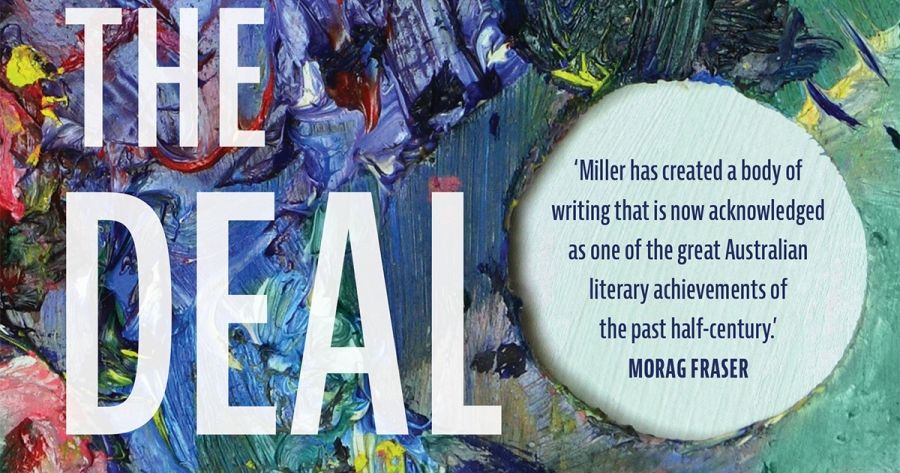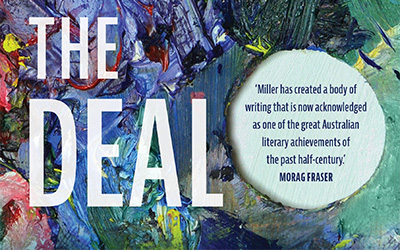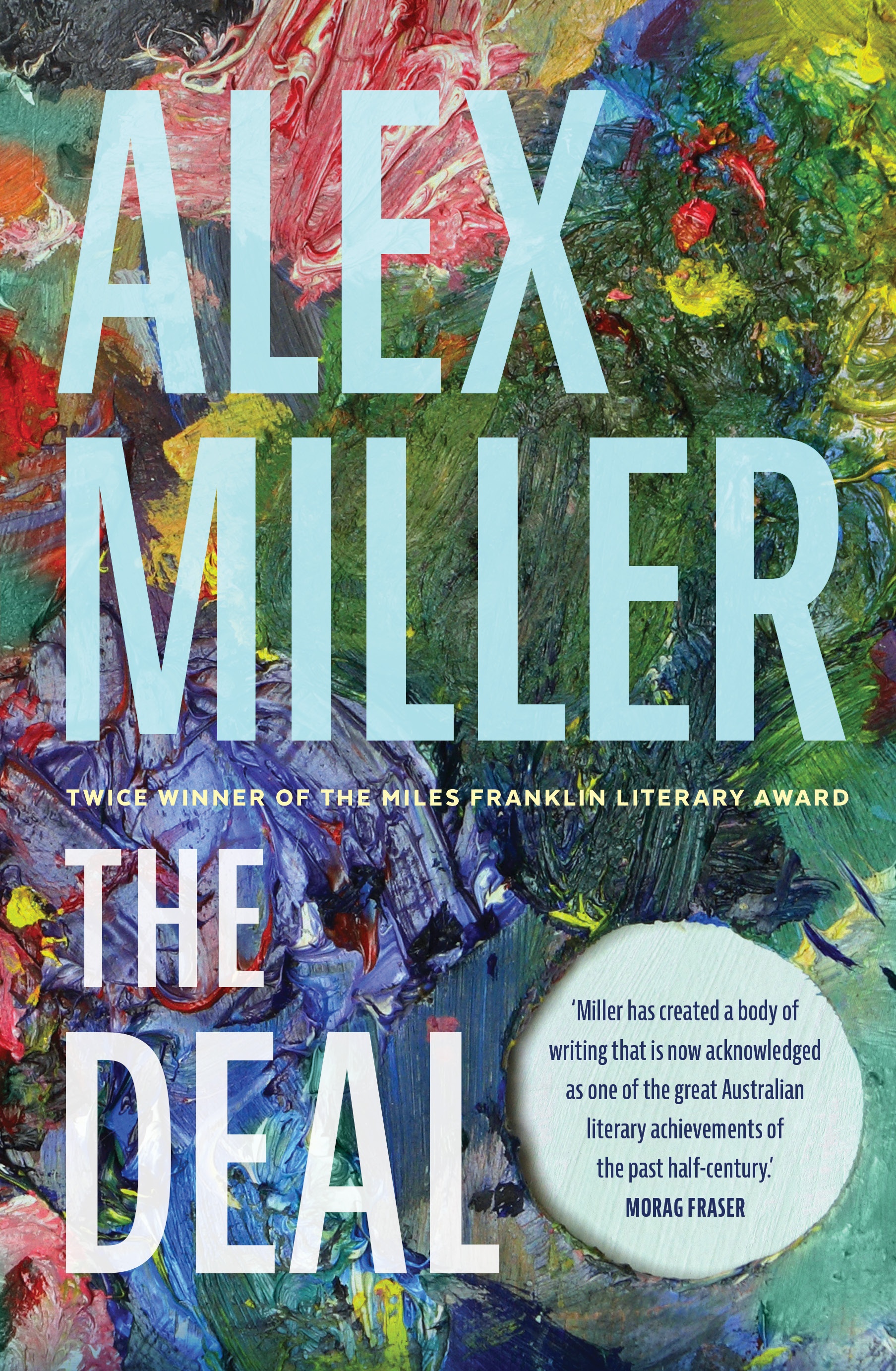
- Free Article: No
- Contents Category: Fiction
- Review Article: Yes
- Article Title: A deal with art
- Article Subtitle: Alex Miller’s absorbing new novel
- Online Only: No
- Custom Highlight Text:
Evocations of artists, art history, and the art world have become a near staple of the literary novel, nationally and internationally. Local examples from the past decade include Emily Bitto’s The Strays (2014), Gail Jones’s The Death of Noah Glass (2018), and Katrina Kell’s Chloé (2024). Alex Miller’s novel The Deal, his fourteenth, is the latest to probe the alluring, sometimes shady art world. It is not Miller’s first such foray; Autumn Laing (2011) was based on the machinations of the Melbourne Heide set.
- Featured Image (400px * 250px):

- Alt Tag (Featured Image): Anthony Lynch reviews ‘The Deal’ by Alex Miller
- Book 1 Title: The Deal
- Book 1 Biblio: Allen & Unwin, $32.99 pb, 281 pp
- Book 1 Cover Small (400 x 600):

- Book 1 Cover (800 x 1200):

- Book 1 Readings Link: https://www.readings.com.au/product/9781761471575/the-deal--alex-miller--2024--9781761471575#rac:jokjjzr6ly9m
In the prologue-like first part, we meet six-year-old Andy and his amateur artist father as they sketch by a pond, each immersed in the ‘deep innocence’ of making art, an activity free of careerist ambition and commercial imperatives. It is England, 1942; after returning from the war front, Andy’s father, wounded in body and soul, is a changed man. Only late in life will he regain the innocent joy of art. For Andy, ‘art remained within the boy, a gift from his father’.
Skip to 2016, and eighty-year-old Andy is living alone in an Australian country town, his wife, Jo, dead, their only child living in Bordeaux. Moreover, Andy learns that his brother in England is terminally ill. Andy hopes ‘to make a pattern out of the random loot of time past’, and recalls how, after Jo’s death, he moved from the city and, after much searching, ‘experienced a feeling of homecoming that was uncanny’ upon first entering the house that has been his for twenty years. We also learn that Andy is ‘the family storyteller’; he has made a success not of visual art but of writing.
The third and longest part, forming the core of this tender and absorbing novel, concerns Andy’s relationship with Jo, and the titular deal. Meeting on a bus trip in the mid-1970s, Andy and Jo immediately bond, and are soon ensconced in a dilapidated terrace in Port Melbourne, bought with Jo’s inheritance from her beloved Aunt Hennie. Jo soon gives birth to a daughter, also named Hennie. Andy makes repairs to the terrace, and he and Jo work part time – she in a job she loves with an antiquarian bookshop; Andy, at Jo’s urging, in a job he doesn’t love, teaching English at a western-suburbs tech school.
Andy’s job brings him one consolation: the intriguing art teacher, Lang Tzu. Andy is immediately drawn to Lang. The two take to having lunchtime drinks at the local pub. Neither cares a jot about teaching or their colleagues. We learn nothing of Andy’s classes; Lang lets his students do what they like. Yet both are artists of a sort: Lang a self-proclaimed ‘failed’ painter and expert in Australian art; Andy the author of three unpublished novels.
Lang regales Andy with stories of lost love and abandoned art. He has set fire to all but one painting he thinks a success: his portrait of his former love (and ongoing obsession), Agatha, regarding the viewer over a shoulder. Lang wallows in ‘bitter wine’, cigarettes, and failure; we might ask why Andy doesn’t heed Jo’s advice that Lang sounds ‘self-obsessed’, and that it is no wonder the idealised Agatha left him for greener pastures.
Yet Andy remains fascinated; Lang offers reconnection with his artist self. He recommences writing, recording in detail meetings and discussions with Lang, who has one further obsession: acquiring a nude by British artist Walter Sickert. This proves the catalyst for ‘the deal’, an arrangement involving Andy. ‘You are my only true friend,’ he tells Andy in what becomes a mantra.
Whether Lang is a true friend to Andy remains unclear. Lang’s proposition, involving slippery art market operators, runs contrary to the unsullied immersion in art Andy found with his father, who, like Bobby’s parents in Miller’s Coal Creek (2014), endures as spiritual guide. ‘You trust people too readily,’ Jo tells him. But out of loyalty and personal interest, he is reluctant to let Lang down.
The Deal is no genre thriller, but Miller quietly builds tension. Lang – a character gleaned from Miller’s The Ancestor Game (1992) – emerges affectingly as a sad man struggling with his identity as a Chinese-Australian. Is Lang delusional, or the author romantic, in the claim that major dealers and curators of public galleries would approach this stay-at-home drunk to authenticate important Australian artworks? I was left unsure. Both Lang and Andy indulge romantic tropes of the struggling artist, but Andy’s loving relationships with Jo and Hennie remain on solid ground and are rendered superbly by Miller. Jo brings ‘a quality of wisdom’ that eludes Andy but enables him to see ‘the bedrock of things’.
Primarily a third-person narrative, The Deal closes with a moving final part set in 2023, written in the voice of the aged Andy. This delicately constructed novel bestows grace on its characters and their (grounded or otherwise) place in the world. Yet it is not art but nature that embodies each character’s relationship to place. An old but flourishing backyard apple tree led Andy to purchase his current home, a tree much like one at his English childhood home. Jo is drawn to the Port Melbourne terrace by a fragrant rose – the same as one in her Aunt Hennie’s garden. And in Lang’s back yard? A pear tree is dying.


Comments powered by CComment